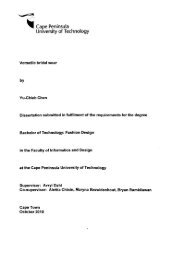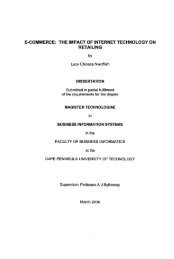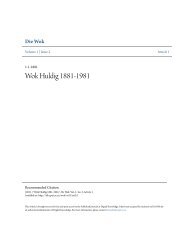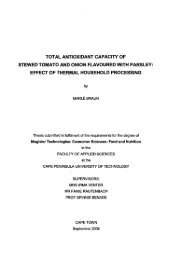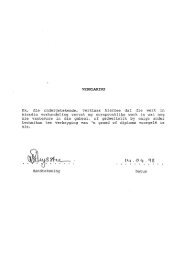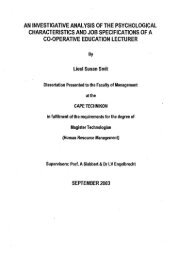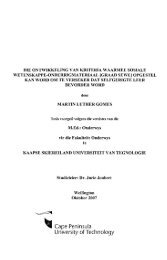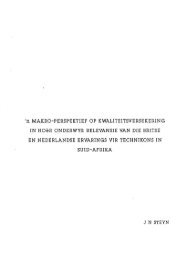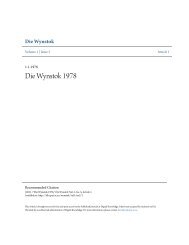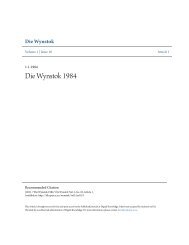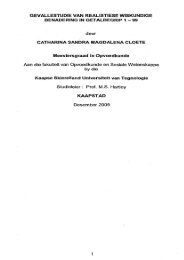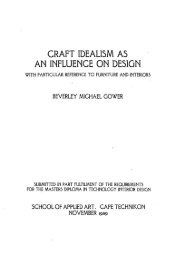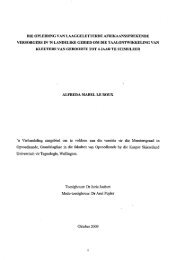the effect of the particle size distribution on non-newtonian turbulent ...
the effect of the particle size distribution on non-newtonian turbulent ...
the effect of the particle size distribution on non-newtonian turbulent ...
Create successful ePaper yourself
Turn your PDF publications into a flip-book with our unique Google optimized e-Paper software.
Appendix B C<strong>on</strong>ference Paper<br />
where TO = DJip/4L and V=Q/A.<br />
2.3 Rheological Characterizati<strong>on</strong><br />
Rheological characterizati<strong>on</strong> involves choosing a rheological model which best fits <str<strong>on</strong>g>the</str<strong>on</strong>g><br />
data (<str<strong>on</strong>g>the</str<strong>on</strong>g> yield pseudoplastic model is used for this study) and <str<strong>on</strong>g>the</str<strong>on</strong>g>n determining <str<strong>on</strong>g>the</str<strong>on</strong>g><br />
values <str<strong>on</strong>g>of</str<strong>on</strong>g> T y , K and n for a particular slurry. The viscous flow data in <str<strong>on</strong>g>the</str<strong>on</strong>g> laminar regi<strong>on</strong><br />
is coincident for <str<strong>on</strong>g>the</str<strong>on</strong>g> different tube diameters and <str<strong>on</strong>g>the</str<strong>on</strong>g> rheological c<strong>on</strong>stants (Ty, K and<br />
n) were determined using <str<strong>on</strong>g>the</str<strong>on</strong>g> method proposed by Lazarus & Slatter (1988) and Neill<br />
(1988).<br />
2.4 Turbulent Flow<br />
Turbulence is a natural form <str<strong>on</strong>g>of</str<strong>on</strong>g> fluid moti<strong>on</strong> which is characterized by large, random<br />
swirling or eddy moti<strong>on</strong>s both parallel and transverse to <str<strong>on</strong>g>the</str<strong>on</strong>g> directi<strong>on</strong> <str<strong>on</strong>g>of</str<strong>on</strong>g> <str<strong>on</strong>g>the</str<strong>on</strong>g> main flow.<br />
Particle paths cross and velocity (both directi<strong>on</strong> and magnitude) and pressure, fluctuate<br />
<strong>on</strong> a c<strong>on</strong>tinuous random basis. The flow behaviour becomes extremely complex and full<br />
rigorous analysis becomes impossible (Tennekes & Lumley, 1972).<br />
The <strong>turbulent</strong> flow <str<strong>on</strong>g>of</str<strong>on</strong>g> <str<strong>on</strong>g>the</str<strong>on</strong>g> n<strong>on</strong>-Newt<strong>on</strong>ian slurries that were tested were modelled using<br />
Slatter's model as well as <str<strong>on</strong>g>the</str<strong>on</strong>g> following models which are already well established in <str<strong>on</strong>g>the</str<strong>on</strong>g><br />
literature,<br />
- Newt<strong>on</strong>ian approximati<strong>on</strong><br />
- Dodge and Metzner (1959)<br />
- Torrance (1963)<br />
- Kemblowski & Kolodziejski (1973)<br />
- Wils<strong>on</strong> & Thomas (1985)<br />
2.4.1 Newt<strong>on</strong>ian Approximati<strong>on</strong><br />
In order to make use <str<strong>on</strong>g>of</str<strong>on</strong>g>standard Newt<strong>on</strong>ian <str<strong>on</strong>g>the</str<strong>on</strong>g>ory, a value for <str<strong>on</strong>g>the</str<strong>on</strong>g> viscosity <str<strong>on</strong>g>of</str<strong>on</strong>g> <str<strong>on</strong>g>the</str<strong>on</strong>g> fluid<br />
is required. Usually <str<strong>on</strong>g>the</str<strong>on</strong>g> term viscosity is meaningless <strong>on</strong>ce a n<strong>on</strong>-Newt<strong>on</strong>ian approach<br />
has been adopted. However, an apparent or secant viscosity (Holland, 1973 and Wils<strong>on</strong>,<br />
1986) can be defined as<br />
Note that JL' is not a c<strong>on</strong>stant for a given fluid and pipe diameter, but must be evaluated<br />
at a given value for TO.<br />
(3)<br />
B.4



